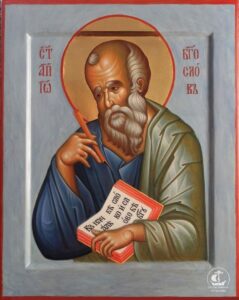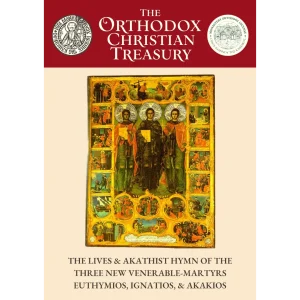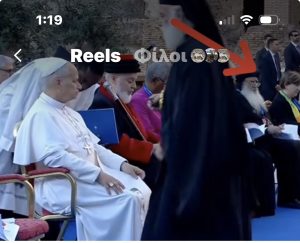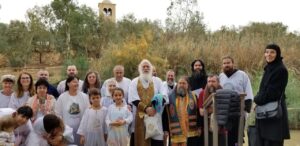Remembrance of the Glorification of Hieromartyr Ermogen Patriarch of Moscow – May 12
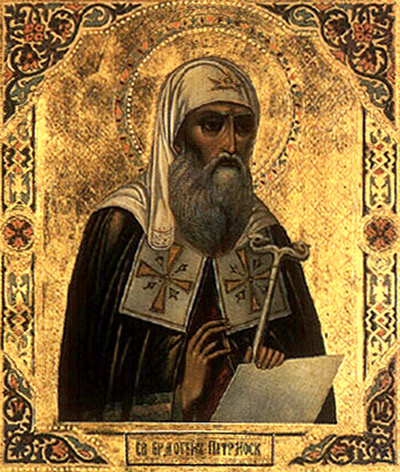
Hieromartyr Ermogen, Patriarch of Moscow and All Rus’, was glorified into the rank of the saints on 12 May 1913.
During the course of three centuries from generation to generation the memory of Patriarch Ermogen as a sainted bishop-martyr was passed on, and popular faith in him grew as an intercessor and supplicant for the Russian land before the Throne of the Almighty. During terrible years of national hardship, the supplicative thought of the nation turned itself to the memory of the heroic Patriarch. The Russian people came to his tomb with their personal tribulations, sickness and infirmity, reverently asking help of sainted Ermogen, believing him a fervent suppliant and intercessor before the Lord. And the All‑Merciful Lord rewarded their belief…
Towards the day of his solemn glorification – 300 years from the time of death of the Priest-martyr Ermogen, – believers from all ends of Russia began to flock to Moscow. Pilgrims hastened to venerate the relics of the holy Patriarch, located in the Uspensky Sobor (Dormition Cathedral) of the Kremlin, where panikhidai were done almost without interruption. On the eve of the glorification a procession was made, at the head of which they carried an icon of Saint Ermogen, and after it a grave-cover, on which the saint was depicted full-length in mantle and with staff. Alongside the icon of the Patriarch they carried an icon of the Monk Dionisii of Radonezh – his fellow-striver in the spiritual and the patriotic deeds in the liberation of the Russian land from Polish-Lithuanian usurpers. At the bell-tower of Ivan the Great glistened a tremendous banner: “Rejoice, Priest-Martyr Ermogen, Great Intercessor of the Russian land”. An hundred thousand candles blazed in the hands of believers proclaiming the Saint of God. At the conclusion of the procession, ‑‑ at the shrine with the relics of the Patriarch, they began readings of the Paschal Canon together with an appended Canon to Sainted Ermogen.
The all-night vigil was done under the open skies on all the Kremlin squares. On this night there occurred a number of healings through the graced prayers of Sainted Ermogen. Thus, for example, a certain sick person came to the Uspensky Sobor on crutches, but became aware of healing as he approached the shrine with the relics of the Saint. Another sick person was healed, having suffered from terrible crippling. They brought him on a stretcher to the reliquary of the Priest-martyr Ermogen, where he received full healing. These and other similar healings, eye-witnessed by a multitude of the faithful, became remarkable proofs of the saintliness of the new Russian wonderworker.
On Sunday, 12 May, at 10:00 in the morning was celebrated Divine Liturgy at the Uspensky Sobor. At the celebration of the solemn glorification of the new Saint was His Beatitude Gregorios, Patriarch of Antioch, presiding over the service. At the finish of Liturgy in all the churches of Moscow there were served moliebens to Sainted Ermogen and procession made to the Moscow Kremlin, – in which took part more than 20 hierarchs, accompanying the solemn procession singing: “O Holy Hierarchical Father Ermogen, pray unto God for us”. From this day began liturgical veneration of Sainted Ermogen. Thus was fulfilled the wish of the faithful Russian people, through whose prayers the Russian Orthodox Church received a beneficent Heavenly Patron of the Fatherland.
The Holy Synod of the Russian Church established as days of celebration to the Priest-Martyr Ermogen, Patriarch of Moscow and All Rus’: 17 February – his repose (the account about his life and works are located under this day), and 12 May – his glorification into the ranks of Sainted-hierarchs.
Great is the all-national significance of Sainted Ermogen, a tireless struggler for the purity of Orthodoxy and the unity of the Russian land. His ecclesial and civil-patriotic activity during the course of several centuries serves as an outstanding example of his ardent faith and love for the Russian people. The ecclesial activity of the Arch-hierarch is characterised by an attentive and strict regard for Divine-services. Under him were published: a Gospel, a Monthly Meneion for September (1607), October (1609), November (1610), and the first twelve days of December, and also there was printed the “Great Primary Ustav / Rule” in 1610. In this Sainted Ermogen did not limit himself to providing a blessing of the edition, but carefully oversaw the accuracy of the text. With the blessing of Sainted Ermogen also was translated from Greek into the Russian language the Service to the holy Apostle Andrew the First-Called (Comm. 30 November) and the celebration of memory was initiated in the Uspensky Sobor. Under the supervision of the Arch-hierarch, there were made new presses for the printing of Divine-service books and a new building for printing was built, – which however was damaged during the time of the 1611 conflagration, when Moscow was burnt by the Poles. Concerned about the order of Divine-services, Saint Ermogen compiled a “Missive directed to all the people, especially priests and deacons, about the improvement of Church singing”. The “Missive” chastises clergy-servers in the non-ustav doing of Church services – for much-talking, and laypeople for irreverent attitudes towards Divine-services.
The literary activity of the Arch-hierarch of the Russian Church is widely known. He wrote: – An Account about the Kazan Icon of the Mother of God and the Service to this Icon (1594); A Missive to Patriarch Job, containing an account about the Kazan Martyrs (1591); a collection of articles in which are examined questions about Divine-services (1598); patriotic documents and appeals, directed to the Russian nation (1606-1613), and other works.
The remarks of his contemporaries speak of Patriarch Ermogen as a man of outstanding mind and erudition: “a Master of great reason and thought and of sharp mind”, “very remarkable and of much deliberation”, “very accomplished of wisdom and refined in book learning”, “ever concerning himself about Divine literature and all the books about the Old Law and the New Grace, and chasing down to the end various Church ustavs and law principles”. Saint Ermogen busied himself much in the monastic libraries, foremost of which, – in the very rich library of the Moscow Chudov monastery, where he copied out from ancient manuscripts very precious historical accounts, located in the their original in the chronicle manuscripts. In the XVII Century they called the Chronicle by His Holiness Patriarch Ermogen the “Voskresensk Chronicle”. In the collected works of the Arch-pastor of the Russian Church and his arch-pastoral documents there are constantly encountered references to Holy Scripture, and examples taken from history, that testify to his profound knowledge of the Word of God and his erudition in the Church literature of his time.
Patriarch Ermogen brought together and displayed aspects from this erudition in his preaching and teaching. The remarks of his contemporaries characterise the moral figure of the Arch-hierarch as “a man of reverence”, “of known purity of life”, “a true pastor of the flock of Christ”, “a sincere upholder of the Christian faith”.
These qualities of Saint Ermogen were quite especially apparent during the Time of Troubles, when the Russian land was overwhelmed by the misfortune of internal chaos, and worsened by the Polish-Lithuanian intrigue. During this dark period, the Arch-hierarch of the Russian Church selflessly guarded the Russian realm, by word and by deed defending the Orthodox faith from Latinism, and also the unity of the Fatherland from enemies both internal and external. For his act of saving his native land, Sainted Ermogen won the crown of a martyr’s death, having passed over into an Heavenly and graciously prayerful intercessor for our fatherland before the Throne of the Holy Trinity.
© 1996-2001 by translator Fr. S. Janos.

